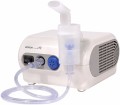Nebulization rate
The nebuliser's nebulization capacity per minute.
The ideal nebulization rate can differ based on factors such as the patient's health condition, the type of disease, and the composition of the inhaled medication, as outlined in medical guidelines. This rate is crucial in assessing the inhaler's effectiveness for specific situations and also influences how long the device operates on a single medication refill.
Some models have a nebulization speed control — in such cases, the maximum value is usually indicated in the characteristics.
Noise level
The nebuliser's maximum noise level during normal operation is a crucial factor for user comfort, especially in situations where loud sounds are undesirable, such as when treating children or during nighttime use. It's important to note that the relationship between decibel levels and actual perceived noise is not linear. For instance, a 3 dB increase corresponds to a doubling of noise, and a 20 dB increase equals a 100 — fold increase in noise. Comparative tables are often used to assess the actual loudness of inhalers, and here are some relevant values for modern devices:
30 dB — comparable to a whisper, the maximum permissible noise level in residential premises at night according to sanitary standards;
35 dB — talking in an undertone;
40 dB — normal speech at a distance of about 10 m;
45 dB — conversation in a normal voice;
50 dB — a conversation is slightly louder than usual, it is considered the maximum noise level that does not cause noticeable inconvenience;
55 dB — car engine;
60 dB — TV at medium volume;
65 dB — loud conversations at a distance of up to 1 m.
Power source
— Mains.
Operating on a standard household network of 230 V, this option enables the creation of nebulisers with versatile power and performance. With constant voltage supply, there's no concern about battery depletion during use. However, it comes with the drawback of requiring a power outlet and limiting mobility. As a result, mains power is commonly employed in stationary nebulisers (refer to "Purpose") but is rarely found in portable models.
— Batteries.
Powered by replaceable batteries of a standard size — most often AA. This self-contained power source enables nebuliser use even in remote locations, providing complete independence from civilization. While quick battery replacement is possible with a spare, it limits the creation of high-power devices. Typically used in pocket models (refer to "Purpose"), this option incurs additional costs, requiring the purchase of disposable spare cells or relatively expensive rechargeable batteries. Moreover, finding batteries can be more challenging than locating a 230 V outlet for device charging, a drawback compared to built-in batteries (see below).
— Battery. Powered by its own original battery, which may be non-removable. Like the batteries described above, this option is intended mainly for compact pocket models; at the same time, batteries can have a fairly high power and work normally even with stationary nebulisers. Their advantages
...are low cost and ease of use: instead of regularly buying and changing batteries, it is enough to periodically charge the device. Among the shortcomings, it is worth noting the impossibility of quickly replacing the battery — a dead battery has to be recharged, which takes time and the availability of a source of electricity. On the other hand, the specifics of the use of most nebulisers is such that this disadvantage is not critical in most cases.
Note that there are models with combined power source — mains/batteries or mains/battery. This combination allows you to combine the advantages of both options and compensate for the shortcomings, and also makes the device as versatile as possible — for each individual case, you can choose the best power option.


